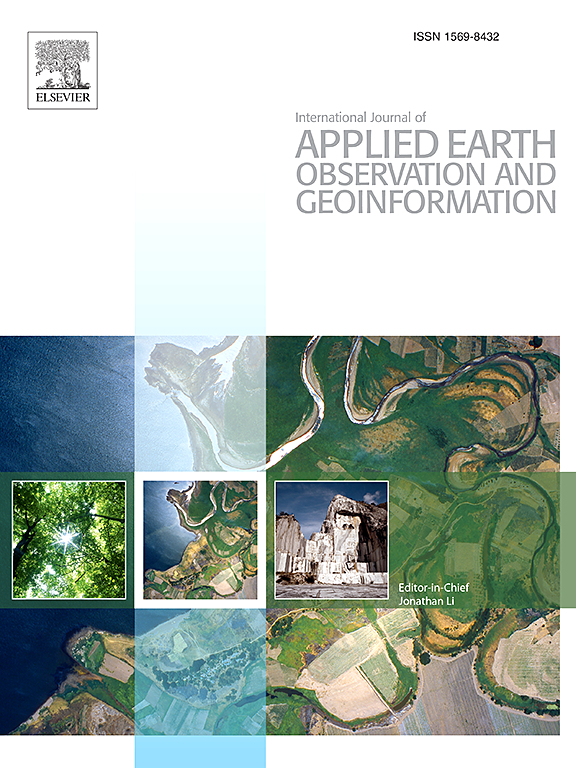InSAR时间序列相位估计的自适应序列估计方法
IF 7.6
Q1 REMOTE SENSING
International journal of applied earth observation and geoinformation : ITC journal
Pub Date : 2025-04-23
DOI:10.1016/j.jag.2025.104552
引用次数: 0
摘要
通过干涉对的加权对准和数据子集的中间滤波,可以减小相位连接中相干估计误差。序列估计器(sequence Estimator, SE)作为一种代表性的方法。它将相干加权矩阵分成更小的子集,使用图像压缩和递归估计来增强相位连接。然而,由于依赖于固定的子集大小和手动参数设置,SE方法具有固有的局限性,这阻碍了其在复杂的自然场景中的应用。在这样的环境中,相干和低相干信号的分布往往是不可预测的。为了解决这一问题,本文提出了一种自适应序列估计(ASE)方法。首先,提出了一种自适应相干加权矩阵划分方法。该算法利用Otsu算法和局部子集合并算法自适应生成数据子集,并根据相干分布动态定制数据子集。其次,提出了一种改进的序列估计器。它从具有多个合并度的列表中选择最优子集,指导图像压缩和递归相位估计。在此基础上,自适应地对相干信息进行优先级排序,同时最大限度地降低去相关噪声的影响,从而提高相位估计精度。利用30幅具有VV偏振的Radarsat-2 SAR图像进行了实验评估,包括对ASE方法与现有方法的定量和视觉比较。结果表明,ASE方法优于其他方法,特别适合于处理自然场景下的可变相干矩阵。与SE相比,ASE方法增加了7%的分布散射点密度。本文章由计算机程序翻译,如有差异,请以英文原文为准。
Adaptive sequential estimator for InSAR time series phase estimation
The coherence estimation errors in phase linking can be mitigated through the weighted alignment of interferometric pairs and the intermediate filtering of data subsets. The Sequential Estimator (SE) serves as a representative method. It divides the coherence-weighted matrix into smaller subsets, using image compression and recursive estimation to enhance phase linking. However, the SE method has inherent limitations due to its dependence on fixed subset size and manual parameter setting, which hinder its application in complex, natural scenarios. In such environments, the distributions of coherent and low-coherence signals are often unpredictable. To address such limitations, this paper proposes an Adaptive Sequential Estimator (ASE) method. First, an adaptive coherence-weighted matrix partitioning method is proposed. Utilizing Otsu’s algorithm and a local subset merging algorithm, it adaptively generates data subsets which are dynamically tailored to the coherence distribution. Second, a modified sequential estimator is proposed. It selects the optimal subsets from the list with multiple merging degrees, to guide image compression and recursive phase estimation. Based on these, the ASE method adaptively prioritizes coherent information while minimizing the impact of decorrelation noise, thereby improving phase estimation accuracy. Experimental evaluation is conducted using 30 Radarsat-2 SAR images with VV polarization, including the quantitative and visual comparisons between the ASE method and existing methods. The results indicate that the ASE method outperforms other methods, and is particularly well-suited to handling the variable coherence matrix in natural scenarios. Compared to SE, the ASE method increases the distributed scatterer point density with 7%.
求助全文
通过发布文献求助,成功后即可免费获取论文全文。
去求助
来源期刊

International journal of applied earth observation and geoinformation : ITC journal
Global and Planetary Change, Management, Monitoring, Policy and Law, Earth-Surface Processes, Computers in Earth Sciences
CiteScore
12.00
自引率
0.00%
发文量
0
审稿时长
77 days
期刊介绍:
The International Journal of Applied Earth Observation and Geoinformation publishes original papers that utilize earth observation data for natural resource and environmental inventory and management. These data primarily originate from remote sensing platforms, including satellites and aircraft, supplemented by surface and subsurface measurements. Addressing natural resources such as forests, agricultural land, soils, and water, as well as environmental concerns like biodiversity, land degradation, and hazards, the journal explores conceptual and data-driven approaches. It covers geoinformation themes like capturing, databasing, visualization, interpretation, data quality, and spatial uncertainty.
 求助内容:
求助内容: 应助结果提醒方式:
应助结果提醒方式:


